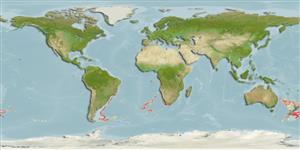>
Gadiformes (Cods) >
Moridae (Morid cods)
Etymology: Guttigadus: Latin, gutta, drop, gum + Latin, gadus = a fish, cod? (Ref. 45335); globosus: Named after C. D. Paulin who described the genus Momonatira (Ref. 45854).
Environment: milieu / climate zone / depth range / distribution range
Ecologia
marino batidemersale; distribuzione batimetrica 1175 - 1600 m (Ref. 31160). Deep-water
Southwest Pacific and South Atlantic: oceanic islands off New Zealand and in the mid South Atlantic.
Size / Peso / Age
Maturity: Lm ? range ? - ? cm
Max length : 18.1 cm SL maschio/sesso non determinato; (Ref. 31160)
Short description
Morfologia | Morfometria
Spine dorsali (totale): 0; Raggi dorsali molli (totale): 75-89; Spine anali 0; Raggi anali molli: 73 - 84; Vertebre: 56 - 59. Body deep; head large; caudal peduncle narrow; lower jaws included (overlapped by) upper jaws when mouth closed; interorbital very wide, 10.3-15.0% SL; barbel on chin very short, 0.3-1.0% SL; lining of mouth dark (Ref. 31160).
Life cycle and mating behavior
Maturità | Riproduzione | Deposizione | Uova | Fecundity | Larve
Meléndez, C., R. and D.F. Markle, 1997. Phylogeny and zoogeography of Laemonema and Guttigadus (Pisces: Gadiformes: Moridae). Bull. Mar. Sci. 61(3):593-670. (Ref. 31160)
IUCN Red List Status (Ref. 130435)
Threat to humans
Harmless
Human uses
Informazioni ulteriori
Nomi ComuniSinonimiMetabolismoPredatoriEcotossicologiaRiproduzioneMaturitàDeposizioneSpawning aggregationFecundityUovaEgg development
Age/SizeAccrescimentoLength-weightLength-lengthLength-frequenciesMorfometriaMorfologiaLarveDinamica popolazioni larvaliReclutamentoAbbondanzaBRUVS
BibliografiaAcquacolturaProfilo di acquacolturaVarietàGeneticaElectrophoresesEreditarietàMalattieElaborazioneNutrientsMass conversion
CollaboratoriImmaginiStamps, Coins Misc.SuoniCiguateraVelocitàModalità di nuotoArea branchialeOtolithsCervelliVista
Strumenti
Special reports
Download XML
Fonti Internet
Estimates based on models
Preferred temperature (Ref.
123201): 2.3 - 3.9, mean 2.9 °C (based on 80 cells).
Phylogenetic diversity index (Ref.
82804): PD
50 = 0.5078 [Uniqueness, from 0.5 = low to 2.0 = high].
Bayesian length-weight: a=0.01000 (0.00244 - 0.04107), b=3.04 (2.81 - 3.27), in cm total length, based on all LWR estimates for this body shape (Ref.
93245).
Trophic level (Ref.
69278): 3.4 ±0.4 se; based on size and trophs of closest relatives
Resilienza (Ref.
120179): Medio, tempo minimo di raddoppiamento della popolazione 1.4 - 4.4 anni (Assuming tmax>3).
Fishing Vulnerability (Ref.
59153): Low vulnerability (12 of 100).
